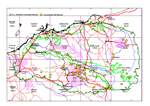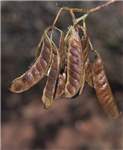Click on images
to enlarge



Photographer: B.R. Maslin

Photographer: B.R. Maslin

Photographer: M.W. McDonald

Photographer: B.R. Maslin

Photographer: B.R. Maslin
, LSWE 7019, lab photo by Fiona McCallum ADJUSTED_sml.jpg)
Seed from one herbarium voucher. Scale in mm. Photographer: F. McCallum.
Botanical name
Acacia monticola J. Black, Trans. & Proc. Roy. Soc. S. Australia 61: 246 (1937)
Common name
Curley-bark Wattle (preferred common name), Minni Ritchi, Red Wattle, Curly-bark Tree and Hill Turpentine
Aboriginal name
Burduwayi (Yindjibarndi), Burduwari (Ngarluma), Kawarr (Nyangumarta) and Mangkalangu (Kurrama)
Description
Resinous shrubs or small trees usually 2-5 m tall, normally more or less 'v'-shaped with a spreading, openly branched crown sometimes with sparse foliage, commonly dividing near ground level into a few main stems, sometimes single-stemmed. Bark Minni Ritchi, i.e. dark brownish red (turning grey with age) and peeling off the stems in narrow strips which curl back on themselves from each end to form scrolls while still attached to the stem. Branchlets covered with minute, straight, silvery, wide-spreading, fine hairs which are often not apparent to the unaided eye (observe at x10 magnification or higher). New shoots bright green and sticky-resinous. Phyllodes elliptic to obovate, slightly asymmetrical, (10-) 12-32 mm long, 5-15 (-20) mm wide, hairs as on branchlets, green but often white (due to dry resin) over the nerves; with 3-5 main longitudinal nerves and a fine, open reticulum between them; the apex rounded-obtuse with a minute, innocuous point, less frequently acute. Inflorescences simple; peduncles 10-20 (-25) mm long, hairs as on branchlets; heads not showy, fragrant, globular to obloid, very rarely shortly cylindrical (10-20 mm long), light golden, the flowers relatively large and not especially densely arranged within the heads. Flowers 5-merous; calyx dissected ¼-½ its length; petals striate. Pods prolific, narrowly oblong, flat but raised over the seeds, 2-10 cm long, (7-) 10-15 mm wide, leathery, hairs as on branchlets, sticky-resinous (especially when young), the resin with a sweetly aromatic odour, transversely reticulate, slightly shiny, mid to dark-brown; marginal nerve thickened and yellow (yellow-green just prior to maturity). Seeds transverse or oblique in the pods, broadly obloid to obloid-ellipsoid, 4-6 mm long and 3-4 mm wide, moderately shiny, dark brown except dull yellow at the depressed central area on outside of pleurogram (slightly darker coloured inside pleurogram); aril white tinged cream.
Characteristic features
Bark Minni Ritchi, brownish red. Young branchlets, phyllodes, peduncles and pods sticky resinous and covered with minute, wide-spreading, fine hairs (best observed at x 10 magnification or higher). Phyllodes relatively small (mostly 12-32 x 5-15 mm), elliptic to obovate, and finely reticulately veined. Peduncles long (mostly 10-20 mm). Heads round; petals striate. Seeds with a pale-coloured central areole, otherwise dark brown.
Distribution and ecology
Widespread in northern and north-western Australia where it extends from the Pilbara and Kimberley regions of Western Australia, eastwards through Northern Territory to central western Queensland. This species has a scattered distribution throughout much of the Pilbara where it grows in sand or sandy loam, usually on rocky hills, slopes or alluvial plains, often along watercourses and wash areas; it commonly forms localized populations in the places where it occurs. Over its geographic range A. monticola grows in a variety of habitats ranging from hills and scarps to stony deserts, along watercourses, on plains and coastal sand dunes. The soils are of low fertility, often skeletal and range from acidic (pH 5.5) to mildly alkaline (pH 7.5). More detailed habitat information is given in Turnbull (1986).
Flowering and fruiting period
Pilbara plants have been collected in flower between April and August but the main flowering flush is from April/May to July. Pods with mature seeds have been collected in September and October.
Variation
Although the growth form of plants in the Pilbara is reasonably uniform (as described above) plants on the Dampier Peninsula in the Kimberly region are sometimes prostrate with a dense, domed crown (being wind-pruned) or attain tree stature 6-8 m tall.
Affinities
Acacia monticola appears most closely related to two other Pilbara Minni Ritchi species, A. trachycarpa (with which it occasionally hybridizes, see A. monticola x trachycarpa) and A. effusa , but is readily distinguished from both by its normally round heads and by its short, broad phyllodes that are covered with minute, fine, spreading hairs (difficult to see without magnification). In the Pilbara A. monticola also hybridizes A. tumida (see A. monticola x tumida var. pilbarensis for discussion), and in the Kimberley region with A. eriopoda and A. tumida var. tumida.
Notes
Acacia monticola is relatively fast-growing; it generally reproduces from seed, does not coppice but has the capacity to resprout from base after mild fires. In some places in the Pilbara (e.g. Joffre Falls) it shows prolific seedling regeneration following fire. Under trial conditions in dry tropical West Africa it attained 2.4 m and 3.7 m in 4 years, but the survival rate was relatively low (Turnbull 1986).
A somewhat decorative species on account of its growth form and Minni Ritchi bark and would be suitable for growing as an ornamental (Chuk 1982). It responds well to supplementary watering and is capable of flowering within a year of planting (Hastings, cited in Turnbull 1986). However, excessive water will significantly increase the likelihood of mealibug attack which is also common in older and sensing plants. Bush cherries or bush apples, which are wasp galls, are common on this species with rates of infestation increasing with watering.
Although A. monticola is not eaten by stock in Australia it is reported to be palatable to cattle in West Africa (Turnbull 1986).
The wood is very hard and strong and appears to be highly resistant to termites; it has been used for gates and light fences, and has some potential for the production of small-sized firewood and for low shelter (Turnbull 1986).
As reported by Juluwarlu Aboriginal Corporation (2003) Yindjibarndi and Ngarluma peoples of the central and western Pilbara used A. monticola in a number of ways. The smoke produced from burning the foliage was used to ward off lingering spirits after someone had died or to punish disrespectful children. Also, the wood was used to make yunbu (spearheads) which were glued to the shaft with spinifex resin and tied with kangaroo sinew. In the Kimberley region it is used medicinally (an infusion from the phyllodes is used to treat bruised and painful areas of the body) and also to make digging and clapping sticks, boomerangs, spear heads and raft pegs (Kenneally et al. 1996).
Conservation status
Not considered rare or endangered.
Origin of name
The botanical name is derived from the Latin montanus (pertaining to mountains) and -cola (dweller or inhabitant). This name was chosen by the author of the species (Black 1937) because the collections known to him at the time all came from rocky tablelands and mountain ranges (e.g. Jervois Range, Haast's Bluff, MacDonnell Ranges, tablelands between Sturts Creek and the Victoria River), and he therefore presumed that this was the preferred habitat of the species. However, as can be seen from the discussion above, the species is not exclusively found on rocky upland areas. Some confusion has existed over the application of the common name to this species and A. trachycarpa , probably because both species have Minni Ritchi bark and consequently, both had received the common name Curley-bark in some literature. We suggest retaining the name Curley-bark Wattle for A. monticola, and using the name Pilbara Minni Ritchi for A. trachycarpa.
References
Black, J.M. (1937). Additions to the Flora of South Australian. No. 35. Transactions and Proceedings of the Royal Society of South Australia 61: 241-246.
Chuk, M. (1982). Trees and shrubs for Tennant Creek. Technical Bulletin No. 1. (Conservation Commission of the Northern Territory: Northern Territory.)
Juluwarlu Aboriginal Corporation (2003). Wanggalili: Yindjibarndi and Ngarluma Plants. pp. 128. (Juluwarlu Aboriginal Corporation: Roebourne, Western Australia.)
Kenneally, K.F., Edinger, D.C. and Willing, T. (1996). Broome and beyond: Plants and people of the Dampier Peninsula, Kimberley, Western Australia. pp. 256. (Department of Conservation and Land Management: Western Australia.)
Turnbull, J.W. (ed.) (1986). Multipurpose Australian trees and Shrubs: lesser-known species for fuelwood and agroforestry. pp. 316. (Australian Centre for International Agricultural Research: Canberra.)
